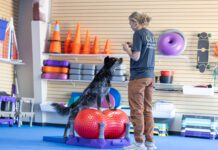The behavior has several different names (inhibitory self-control, emotional self-control, self-regulation), but the term “impulse control” is used frequently in dog training. It means that dogs can resist the temptation to perform an unwanted behavior that would give them access to a desired reinforcer – that is, they can control themselves.
Puppies aren’t born with impulse control (nor are children); it has to be learned – and it can be encouraged and deliberately taught! Teaching your dog to develop his impulse control is a valuable use of your time because, as dogs learn to control their behavior, we can relax and enjoy their company without feeling like we always have to control them.
Generally, humans don’t consider a dog to have a problem with self-control unless his impulses drive him to exhibit behaviors we don’t care for. It’s when dogs do things like help themselves to food on the coffee table or kitchen counter (counter surfing), jump up on people when greeting, dart out doors before invited to do so, or grab things from the hands of their humans that dogs tend to be labeled as lacking in impulse control. From the canine perspective, however, a dog who does these things is just helping himself to something he wants: food, contact with humans, freedom, or a desired toy or other item.
Fortunately, with relative ease, most dogs can learn to resist the impulse to help themselves to these things – practicing delayed gratification or accepting an alternative reward – when their humans implement several impulse-control behaviors already frequently taught in the force-free training world, including Wait, Leave-It, Polite Greeting, Mat, On-Off Switch, and more.
WAIT
As much as we force-free trainers love teaching dogs to do stuff, I will admit that “Wait” is one of the most useful behaviors I teach my dogs, as well as my favorite impulse control exercise. Unlike a formal “Stay” cue, which means “Stay in the exact position you are in and don’t move until I tell you to,” I use “Wait” more informally to mean “Pause.”
We teach “Wait” using a food bowl. This gives you one or two built-in training sessions every day (depending on how often you feed your dog) – no excuses! “Wait” can then be easily generalized to waiting at doors, or any other situation where you want your dog to be able to control herself (i.e., not rushing forward to greet the senior citizen with the walker, or not grabbing the hotdog out of the toddler’s hand). Here’s how to teach it:
1. Have your dog sit and tell her “Wait!” Put a mixture of some of your dog’s regular food and some high-value treats into her food bowl. You can use her regular food as a treat if she’s highly food-motivated, but to make a greater impression, use the higher-value treats for reinforcment.
Hold the bowl at shoulder level (off to the side so you’re not lowering it directly under her nose), and before she can (or does) move, mark her “pause” with the “click!” of a clicker or a verbal marker such as the word “Yes!” Then take a treat out of the bowl and feed it to her.
If she gets up before you click, tell her “Oops, sit!” and try again.
If she gets up after you click and treat, just ask her to sit again before the next repetition. Repeat several times, telling her “Wait” each time.
2. With the bowl at shoulder level, tell her “Wait,” and lower the bowl a few inches. Mark (with a click or “Yes!”) if she’s still sitting, and quickly raise the bowl back up; then take a treat out of the bowl and feed it to her.
If she gets up when you lower the bowl, try again, and lower it only a fraction of an inch.
3. Gradually lower the bowl a bit more, still starting at shoulder level, telling her “Wait” each time, with several successful repetitions at each new position before going lower. If you get two “Oops!” in a row, you’ve gone too quickly; back up to where she can succeed and proceed more slowly with your bowl-lowering.
4. When you get the bowl all the way to the floor, set it down, click, and pick it back up before giving your dog the treat. Repeat several times, telling her “Wait” each time. (Be ready to raise the bowl quickly if she tries to go for it!)
5. Next, when you get the bowl to the floor, click, but leave the bowl on the floor while you feed her the treat. Repeat several times, telling her “Wait” each time.
6. Finally, tell her “Wait,” set the bowl on the floor, click and treat, and tell her, “Okay, you can have it!”
Dogs who naturally have better self-control may “get it” in one session. Those who are more challenged by their impulses may need to practice over a period of several days or more before you get the bowl to the floor. At each mealtime practice session, work as long as practical for you and your dog, then just go ahead and set the bowl on the floor with an “Okay you can have it!”
Eventually you’ll be able to ask her to wait while you put the bowl on the floor, and you won’t have to mark and treat, just release her; her meal is the reward.
LEAVE IT

I use “Trade” when a dog already has something that I want in her mouth. (See “Protocol for Teaching a Safe ‘Trade’ With Your Dog,” May 2020, for information about how to teach your dog to happily give you something he has that you want.) But I teach “Leave It” for the random object on the ground that my dog covets – and that I don’t want her to grab. Here’s how:
1. Show your dog that you have a high-value “forbidden object” in your hand – something you’re going to tell her she can’t have. I use freeze-dried liver cubes for this – they are high-value and durable. Let her sniff it, lick it, even nibble at it, but don’t let her have it.
2. Say “Leave It!” as you hold up the cube, then immediately place it on the floor under your foot, to protect it. (Note: Wear sturdy shoes. Do not do this barefooted, with open sandals, or in your nicest shoes!)
3. Let your dog sniff, lick, nibble, and chew in an effort to reach the treat under your foot. She might even paw at your shoe (hence, the no-sandals or bare feet suggestion). If her tongue can reach the cube under your shoe, tip your toe forward so she can’t lick it.

4. Wait. Don’t repeat the cue; she will eventually give up. The instant she stops sniffing, licking, etc., or looks away, even by accident, mark (click your clicker or use a verbal maker, such as the word “Yes!”) and give her a tasty treat. She’ll probably immediately return her attention to the forbidden object under your foot, so just wait some more. Don’t repeat the cue. When she looks away again, mark and treat again.
5. If possible, mark-and-treat again before her nose returns to your foot. You want to reinforce “Look-away, look-away, look-away, keep-looking-away” not “look at foot-look away, look at foot-look away.”
6. After several repetitions, pick the cube up, show it to her again, repeat the “Leave It” cue, and place it under your foot again.
7. When she looks away from the cube easily, move your foot slightly to uncover the treat and give repeated mark-and-treats as long as her nose doesn’t return to the treat. She gets rewarded for staying away from the cube even when it’s visible and seemingly accessible. Keep your foot close! If your dog dives for the food, just re-cover it with your toe to prevent her from getting it. Mark/treat again when she looks away.
8. If your dog completely ignores the forbidden object on the ground, try tapping your toe next to it to draw her attention back – but be ready to cover it up quickly! Remember, she doesn’t have to look back at the cube and then look away – you want continuous “look-away” behavior.
9. Eventually you’ll see your dog’s “Aha!” moment – that golden moment in training when you see your dog really understands. With Leave It, that moment happens when she looks at the exposed treat, considers it for a moment, then looks up at you in anticipation of the mark and treat. Celebrate!
10. Next, place the forbidden object on the floor without covering it with your foot (be ready to protect with your foot!). Repeat numerous times until you can place it in plain view on the floor and she doesn’t try to get it.
Now you can generalize Leave It to more real-life situations. (For help with generalizing the behavior, see “How to Teach a Dog to ‘Leave It’” June 2018.)
POLITE GREETING
This is an important impulse-control behavior in any dog’s repertoire. It requires that you not reinforce her for jumping up – and that you prevent the rest of the world from reinforcing her as well! – while you reinforce her generously for an incompatible behavior such as Sit. You can simply turn your back and step away when she jumps up if she’s roaming free (or step into another room and close the door) – and you can use a leash or tether for more concentrated practice.

1. With your dog tethered to a solid object, approach slowly and calmly, wait for her to sit, then mark (with the click of a clicker or a verbal marker such as the word “Yes!”) and feed her a treat. If she jumps up, just step back out of her reach. Note we didn’t tell you to say “Sit.” We want her to think of and offer that behavior on her own, not be waiting for a cue. Use body language (such as leaning back and/or lifting your hands to your chest) to help her sit if necessary (quickly fade the use of this body language). Just don’t use your regular cue for Sit!
2. As she starts offering sits consistently when you approach (and you consistently reinforce these), gradually increase the energy of your approach until you can greet her with excitement, and she still sits and stays sitting until you release her.
3. Now generalize the behavior to the rest of the world. With your dog on leash, have another person approach her. Instruct them to approach calmly and tell them to step back if she jumps up. When she sits politely at their approach, mark and treat her for sitting. They can then greet and pet her but remind them to move back if she gets up.
Eventually, if you want, you can have the people approaching feed her a treat – providing they understand they must move away if she gets up.
MAT

The introduction of the “place mat” is a brilliant addition to the force-free training repertoire. The place mat is a portable rug, bed, or blanket that you teach your dog to lie down and settle on. The more comfortable the mat, the easier the training.
When your dog learns to park herself on her mat you have an incredibly useful tool to help with impulse control at home as well as in new environments or those with guaranteed arousal-causing distractions. Here’s how to train the behavior:
1. Hold your dog’s mat and show great interest in it: Examine it, talk about it, sniff it, and so on, until your dog shows interest in what you are doing.
2. Place the mat on the floor. Have a supply of medium- and high-value treats. When your dog looks at, sniffs, or shows any interest in the mat, mark and place a medium-value treat on the mat for your dog to take.
3. Continue to mark for any mat-related behaviors (except for grabbing it and playing with it!), placing a medium-value treat on the mat each time you mark.
4. Any on-the-mat-behaviors (OTMBs) deserve a mark-and-treat, but if she offers a down, she gets a high-value treat. Other offered OTMBs still get medium-value treats. Continue to mark any OTMBs, but occasionally cue her to “Down” on the mat. When she does, mark and give her a high-value treat.
5. After you have cued, marked, and treated a half-dozen random downs interspersed with her other behaviors, pause for several seconds and see if she chooses to offer you a down when she doesn’t get marked for other behaviors. If she does, mark and feed her several high-value treats. If she doesn’t, go back to marking any OTMBs, interspersing cued downs. Again, deliver high-value treats for downs and medium-value treats for other behaviors.
6. Repeat step 5 until your dog begins offering downs during your pauses. Your dog is learning that downs get better rewards. She should soon begin offering only downs on the mat, even though other behaviors will still get medium rewards.
7. Now give your dog a release cue, move a few steps away from the mat and invite her to follow you. When she does, stand quietly and ignore her – no marks, treats, or praise. Most dogs will return to the mat to prompt you for more treats. (If she doesn’t, go back to Step 5.) If she does, start marking and treating again, using medium-value treats for any behavior, high-value treats for downs. You are reinforcing her for returning to the mat. Downs are great if they happen, but remember to reward any OTMBs. Gradually increase your distance from the mat.
8. When she consistently/quickly returns and lies down on the mat each time you move away, increase time in small increments – a few seconds at a time. If she gets off the mat before you release her, pick up the mat, ignore her for a minute, place the mat down and try again.
9. When your dog will go to her mat and lie quietly on it for an extended period of time, you can add your cue – “Mat,” “Place” – or whatever you want to call it. Practice sending her to her mat from increasing distances and eventually from anywhere in the house.
10. Finally, add distractions and generalize the behavior. Start with kindergarten-level distractions – jump once, jump twice, clap your hands … gradually work up to college level – kids running through the house, dropping food on the floor … and eventually PhD work – doorbell ringing, visitors entering, and anything else that might challenge your dog’s self-control. When she’s good with distractions in the home – take it on the road; generalize it to the rest of the world!
ON/OFF SWITCH
Sometimes your dog will just get excited by some stimulus. Many dogs get super amped when the leash comes out because it is such a reliable predictor that “good stuff is about to happen!” Asking them to calm down can be counterproductive – you’re paying attention to them (reinforcing!) as they leap about, and they just get more excited as you interact with them. I use “Oops!” as a “no reward marker,” meaning “That behavior doesn’t get reinforced – in fact that behavior makes the good stuff go away …” and then I take away the opportunity for reinforcement.
If I have the leash in my hand when my dog starts to leap with excitement, I say, “Oops!” and lay the leash on the table, then go sit down. If I was holding a toy, I’d say, “Oops!” and hide it behind my back or turn away. If I was opening the door, I’d say, “Oops!” and walk away.
When your dog can remain calm as you pick up the leash, hold up the toy, or open the door, she has learned impulse control – she can control her excitement in order to make the good stuff happen.
Note: I prefer “Oops” to the “eh-eh” that some trainers use, as it’s really hard to say “Oops” in an aversive tone of voice, while “eh-eh” can end up sounding quite nasty. The intent is simply to give information in a neutral or cheerful tone – “That behavior made the good thing go away” – not to be angry or intimidating to the dog.
Your goal? To help your canine companion learn to control her own behavior so you can live harmoniously together in a relationship of mutual love, trust, and respect, knowing your dog will choose to do the right thing even when temptation looms, and knowing you don’t have to be the behavior police.






